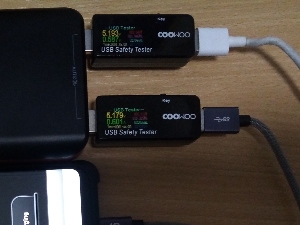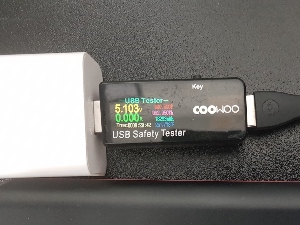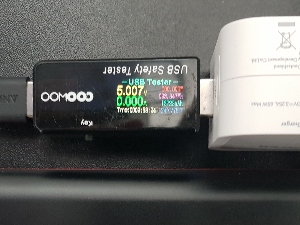Review: EC Technology Portable Charger 22400mAh

The EC Technology Portable Charger 22400 is one of the cheapest and most popular power banks on Amazon (22k reviews with an average rating of 4.6). What makes this power bank so popular? Read on to find out.


Pros & Cons:
Pros:
- ports for output charging
- Can charge 3 devices simultaneously
- High-quality battery
- Robust materials
- Good charging speed
Cons:
- Average recharging speed
- Mediocre design
- Lack of USB-C
Rating
Power & Performance (1 to 5 stars)
Design & Build (1 to 5 stars)
Technology (1 to 5 stars)
Overall Rating (average of above)
Key Product Specifications
Key Specs:
Capacity
22,400 mAh / 82.8 WH
Dimensions (LxWxH)
6.3 x 3.1 x 09 in / 16 x 8 x 2.3 cm
Weight
16.3 oz / 426 g
Output & Input Charging:
Average Charging Time of a Mobile Phone (average battery capacity 3000mAh)
1 hour and 35 minutes
Average Recharging Time (from 0% to 100%)
9 hours and 45 minutes
Ports
- Micro USB Input: 5V/2A
- 3 x USB-A Output: 5V/2.4A
Charging Technology
- AUTO IC Technology - detects and adapts to your device’s unique charging protocol enabling it to charge at full speed
- Over-Voltage Protection
- Over-Current Protection
- Short-Circuit Protection
Flight Status
- Under 100WH
- Safe to take on board.
Other Features
- 12 months warranty
- Lifelong customer support
Ideal For?
- Travelers
- Adventurers
- Businesspeople
- Students
What’s Inside?
- EC Technology Power Bank 22400
- USB-A to Micro USB Cable
- Manual in multiple languages

Power & Performance
Battery Capacity
Battery capacity in mAh and Watts
The EC Technology Portable Charger 22400 has a battery of 22,400 mAh / 82.8 Wh. This massive battery should be sufficient to charge most phones 5 or even 6 times.
Capacity test
Have you ever wondered whether a power bank has its battery capacity? Does it really have 5,000 mAh or 10,000 mAh, as advertised? What is the real battery capacity?
To check the actual battery capacity we need:
The fully charged power bank
A USB tester that shows the current, voltage, mAh, and charging time.
The USB mini adjustable load receives energy from the power bank and releases it safely via the fan. This is the safe way to discharge a fully charged power bank and measure the real battery capacity.
I connect the dummy load (amperes are set to 2) to the USB tester, then plug it into the fully charged power bank. Once that’s done, I wait until the power bank’s battery goes flat. The screen on the USB tester will display the Watt-hours and the amount of mAh consumed. These data show the real battery capacity.
Using the aforementioned procedure, I tested (Name of the power bank). Here are the results:
Capacity Test

- Discharge Time - 7 hours
- Watt-Hours - 72.1 Wh
- Ampere hour - 14,068 mAh
The real battery capacity is 14,068 mAh. This mAh measurement shows you the energy you will fully use to charge your mobile phone. It’s not 22,400 mAh because the unit is converting energy from 3.7V (the power bank’s battery voltage) to 5V (USB voltage). This loss occurs in every power bank.
When you know the advertised and real battery capacity, it’s possible to measure the battery efficiency, which in this case is 85%. Manufacturers frequently don’t share this information. Efficiency above 90% is considered very good. It’s a solid battery, meets the industry standard.
Disclaimer: Every test can produce different results, but only small variations.
How many times can you charge the most popular mobile phones in 2020?
To put the battery capacity into perspective, I will use a formula for Real Battery Capacity and calculate how many times the EC Technology Portable Charger 22400 can charge the top 10 most popular mobile phones in 2020. Perhaps you own one of them, or at least you know your mobile phone’s battery capacity.
From the previous test, we know the real battery capacity is 14,068 mAh.
Once we know the real battery capacity, we simply divide it by the enlisted mobile phones’ battery capacity to find out how many times it can be charged.
Mobile Phone Model | How Many Times Can It Be Charged? |
4.61 | |
3.05 | |
2.88 | |
2.88 | |
3.24 | |
7.13 | |
2.88 | |
4.13 | |
3.09 | |
2.60 |
The EC Technology Portable Charger 22400 is the power bank you want if you own a mobile phone with a large battery (e.g., the Moto G8). The full power bank should deliver enough energy to charge phones with batteries larger than 4,000 mAh about three times. If you own a phone with a battery rated 3,000 mAh or less, you’ll get 5 full charges. This is the power bank for heavy tasks!
Output Charging
Charging Time & Power Usage
Power banks are used mainly to charge devices. Therefore, this review would not be completed without testing output charging. For this, knowledge of the device’s charging time is crucial. Frequently it is one of the most important factors in the purchase of a power bank.
For these tests, I used three mobile phones:
Huawei P10 with a battery of 3200 mAh (Huawei SuperCharge)
Samsung S8 with a battery of 3000mAh (Adaptive Fast Charging)
- Samsung Galaxy A10 with a battery of 3400 mAh
The two first phones support fast-charging technology, the last one doesn’t.
Additionally, I tested the iPad Model A2197 2017 (battery capacity around 8,800 mAh). The manufacturer claims 2 full charges with its power bank.
To record data (current, voltage, mAh, time) I used a USB tester.
Real-life examples of test-charged phones demonstrate what you can expect after purchasing a power bank.
The EC Technology Portable Charger 22400 offers loads of energy and 3 ports for output charging. All 3 ports can be used simultaneously. Clearly, it will be useful for people with many devices. I find it especially useful when I’m traveling with friends – plug 3 phones plugged into one power bank, wait 2 hours or so, and the phones are fully charged.
The question is: how fast is it? One port can deliver energy at a maximum rate of 5V/2.4A. However, if you want to use 3 ports simultaneously, the maximum speed for all of them is 5V/3.4A or roughly 1.1A per port. As a result, the charging speed might be extremely slow. Let’s check out the test results.
Charging via USB-A (Huawei)
%20-%20Finish.jpg?alt=media&token=f93a2a19-4039-4a5d-823f-5f9ec445b32b)
It took 1 hour and 30 minutes to charge the Huawei P10. No surprises here. This is a solid and expected time. The power bank delivered 2,377 mAh / 12 Wh in total.
Charging via USB-A (Samsung)
%20-%20Finish.jpg?alt=media&token=3d035099-a23f-4578-a0ec-52ccbbcc6e11)
It took nearly 1 hour and 40 minutes to charge the Samsung S8 – slightly longer than Huawei P10, despite Samsung's smaller battery. But it’s still a decent time. The power bank delivered 2,019 mAh / 10.2 Wh in total.
Charging two phones simultaneously

To charge two devices at the same time, the power bank needed 1 hour and 45 minutes. This is a solid time, slightly more than required for a single phone. The power bank delivered around 4,250 mAh / 22.1 Wh in total.
Charging three phones simultaneously

Due to the layout of the ports, only two USB testers were used. It took 2 hours and 10 minutes to charge all three mobile phones – a solid time, slightly faster than I expected. The energy flow was constant at 5V/1.1A. The power bank delivered approximately 7,000 mAh / 35 Wh in total. It’s worth highlighting that 3 LED lights were still flashing at the end!
Charging iPad

It took 4 hours and 42 minutes to charge the iPad. This is a solid time. The port was charging at its maximum speed (5V/2.4A) for most of the time. The power bank delivered 8,394 mAh / 42.8 Wh in total.
A roundup of output charging
Overall, this power bank’s performance was better than I expected. Individual phone charging was solid, and most phones should fully charge within 2 hours. My concern about slow simultaneous charging didn’t come true; it took slightly more than 2 hours to charge 3 phones – a great result! On top of this, the charging time of the iPad was great. If at least one port could deliver fast charging, then this device could easily compete for the top podium position. The manufacturer claims 2 full charges of an iPad, but this is unlikely, and probably closer to 1.7-1.8 charges.
Input Charging
The EC Technology Portable Charger 22400 is equipped with a standard Micro USB port 5V/2A. This battery should be fully charged in 10 hours.
I charged the power bank twice. The first test, via a standard charger rated at 5V/2A charging speed; a charger most of us have. For the second charge, I used the charger rated 65W, the fastest type of charger, able to charge compatible laptops.
Recharging via Huawei Charger 5V/2A

It took 9 hours and 30 minutes to charge the power bank. For this battery capacity and port capabilities, this is a good time. The power bank received 18,293 mAh / 93 Wh in total.
Recharging via RAVPower Fast Charger

It took nearly 10 hours to charge the power bank. This is standard and the time I expected. The device received 18,722 mAh / 93.8 Wh in total.
A roundup of input charging
Overall, it’s just standard input charging, nothing more. Given its battery capacity, it could benefit from a higher voltage and USB-C port. But you can’t have everything, right?
Score
Design & Build
Dimension & Weight
Weight in ounces and grams
16.3 oz / 426 g
Measurement in inches and centimeters
6.3 x 3.1 x 09 in / 16 x 8 x 2.3 cm
The EC Portable Charger 22400 is not a featherweight power bank. It weighs over a pound, so carrying it in a pocket with your phone will be inconvenient, but this is the price of a big battery. The bright side is its durability.
Design & Material
EC power bank 22400 stands out from its competitors’ power banks in that it combines two colors: red and black. While most power banks are mainly black, the red stripe that runs around the narrow edges of this one creates a nice contrast.




The power bank is built of three parts. The main two parts are solid black plastic (the front and back cover). The sides of the device are one-piece, in red. It's very solid construction. It’s smooth to the touch. It’s not a rugged power bank, but I’d consider taking it into the wilderness.
On one side, in the center, is EC Technology’s logo and 4 LED blue lights serving as the battery indicator. Each light indicates 25% battery. When charging, the power indicator flashes. When it’s full, all four indicators are on. The other side has a label showing the power bank’s basic information.
The most important part of the power bank, for users, are the ports. They are on the upper edge of the device. Its three ports are this device’s most important feature. The USB-A ports are equally aligned across the edge with a LED flashlight below the middle port. These ports are used to charging your devices. The micro-USB port is on the left edge, close to the corner, and is used for recharging the power bank.
This model has a flashlight located near the ports. To turn it on, press the power button for 3 seconds. The same procedure and time is needed to turn it off.
The power button is on the right edge of the device, near the upper corner, close to the ports. To check the battery, simply press the button and the lights will flash.
Overall, it’s a nice-looking power bank, with attractive colors. That said, I find it a bit bulky, even for a big power bank.
Score
Technology
Ports
This power bank has what many power banks lack – three output ports. You might wonder who would need three ports, but when you travel and have multiple devices or/and share the power bank with your companions, the possibility of charging three devices simultaneously makes a significant difference.
The flip side is the maximum output, which is only 5V/3.4. If three devices are connected, then the charging speed is very slow at 5V/1A. This is the trade-off you make for having three ports. But the tests showed a decent three-phone charging speed , despite the low rate.

Micro USB Input: 5V/2A
3 x USB-A Output: 5V/2.4A one port (5V/3.4A MAX)
Tech
The charger has support for plenty of safety tech including Over-Voltage Protection, Over-Current Protection, and Short-Circuit Protection.
EC Technology implemented AUTO IC Technology in this power bank. This technology detects and adapts to your device’s unique charging protocol, enabling it to charge at full speed.
Score
Conclusion
Overall Opinion
EC Technology isn’t usually considered one of the famous power bank manufacturers, such as Anker or RAVPower, but this model proves it should be. It has a high-quality battery, robust construction, the ability to charge up to 3 devices simultaneously and a small but useful flashlight. It doesn't look as good as an Anker product, but is half the price and provides nearly the same charging features. If you’re looking for a cheap, good-quality power bank with a substantial battery, this should be your choice.